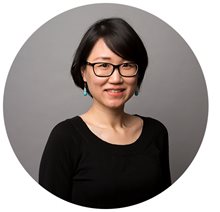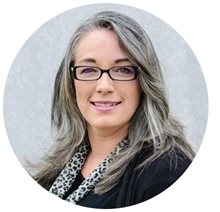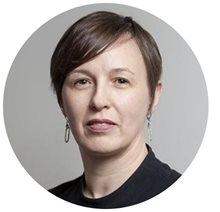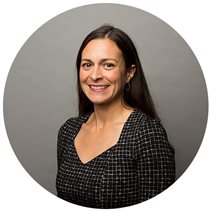A lot of history is measured in “firsts,” such as the first brain surgery, or the first diagnosis of Alzheimer’s disease. Once someone is the first, there is space for others to come after them.
This can be true for women in science, who can be dealing with many firsts or onlys, in a field where they are underrepresented.
We asked some of the women pioneers and trailblazers who work at Baycrest what it was like to be the first or only at something, and what is being done to help the people coming after them.

Dr. Jean Chen
Canada research Chair in Neuroimaging of Aging AND Scientist at the Rotman Research Institute
“It is quite exhilarating, to be honest,” Dr. Chen explains, “I have worked in a male-dominated field since starting University at age 17, so I am no stranger to being “one of the only women in the room,” [and] I have certainly had many “first racialized woman in the room” experiences.”
Dr. Chen’s expertise in imaging, using fMRI to study neuronal and vascular interplays and how the physical and functional brain change during neurodegenerative diseases, make her a sought after expert.
“Research involves a lot of ups and downs, including failed experiments, rejected papers, unsuccessful grants,” Chen explains, looking back. “I had some tough times in my career, but in hindsight, each of these moments has been a blessing in disguise.” She credits a strong work ethic, a humble attitude, and support from her family for her success.
Dr. Chen credits Baycrest with a part of her victories as well, “this collegial and supportive environment has contributed to my success and allowed me to forget the barriers that still exist for women researchers.”
“Women play important roles in Baycrest’s leadership, and this offers a unique learning opportunity for me,” she explains.
Dr. Chen is beginning to look forward, to ensure that the other women she works with have the support she has been granted. “Most recently, I started an initiative to support other female scientists in my department, because I think peer-to-peer support is also an indispensable part of our psychological safety net.”

Dr. Donna Rose Addis
Canada 150 Research Chair in Cognitive Neuroscience of Memory and Aging AND Senior Scientist at the Rotman Research Institute
Dr. Addis is also no stranger to being the first in the room. She was one of only two women to receive the Rutherford Discovery Fellowship in New Zealand, and she was often the only woman neuroscientist in meeting with university leadership in Auckland, from which she hails. Sometimes, instead of being alone however, she brought backup, “I was also the youngest ever person elected as a Fellow of the Royal Society of New Zealand, at age 39, a society traditionally dominated by men. So I made sure to take my mum and my closest mentor Lynette Tippett with me to the induction ceremony!”
Dr. Addis credits the women in her family as being some of her biggest supporters, “my mum and Nanna have always been behind me,” she says, “their role modelling as strong women who did the best they could do in whatever they did, be it working in a factory or a store or, in my case, brain science.” While her mother has always had faith that she make a difference, there were some tough times when Dr. Addis first chose her path.
“New Zealand has a cultural phenomenon called the Tall Poppy Syndrome, and so as an academic achiever, and a female one at that, I was socially ostracised at school and even at university,” she explains. “That always meant that I was having to “choose” between achieving and having friends which was awful for a young person!” When Dr. Addis won a Commonwealth scholarship to do her PhD at the University of Toronto, it was tough to leave her family and the place she loved behind, but Baycrest was the only place she could even dream of leaving home for.
“It truly had been a dream of mine to work at the Rotman – somewhere that is not only renowned for its world leading brain science and where other women neuroscientists have thrived but also a place with a strong female leadership in research, and an institution where compassion is a value.”

Dr. Amanda Grenier
Norman and Honey Schipper Chair in Gerontological Social Work
“You get kind of used to it,” Dr. Grenier says about frequently being the first or only woman in the room, pointing out that for many years she was one of the only women on panels or in meetings. “Now, when I’m invited into these moments, I ask if there will be other women on the panel, and how we can diversify the group.”
This direct approach is also something she enjoys about working at Baycrest, “there is a deliberate attempt to have underrepresented groups at the table,” she says. Colleagues with different perspectives are sought after for their thoughts, and those contributions are not only valued but championed.
This is different from the start of Dr. Grenier’s career. When she was selecting her field and research she was told there were not opportunities in qualitative, theory-focused work on aging – much of her work is centred around collecting the stories of older adults and contrasting them with the way society and policy frame aging. “The irony is the opposite has been true.”
That early career experience now informs how she works with students, “it’s not an ‘if’ or ‘ever’, it’s ‘when’. When are their ideas going to be challenged?”
She firmly believes in giving students a toolbox to advocate for themselves in the, sometimes intimidating, academic setting.
Through her mentorship and guidance, Grenier is always seeking to bring more women to the table, “It’s about sharing information, sharing knowledge, and about sharing that power.”

Dr. Rosanna Olsen
Scientist AT Rotman Research Institute
“I have always been really determined-- and a little stubborn-- which I think are requisite qualities for trailblazers,” Dr. Olsen jokes when asked if she’s surprised to be considered a trailblazer.
Sometimes though, trailblazing can be tough, “[it] was especially difficult when my kids were young (under 5)! I often felt guilty and homesick when I travelled to give a talk or attend a conference.”
Dr. Olsen’s work in the creation of memory, and how the brain changes and forgets with age, meant her travel itinerary was quite full. She has also helped develop specialized and reliable tools for regional brain measurements.
Dr. Olsen explains she’s been fortunate to have worked with many gender-balanced and progressive institutions, including Baycrest. “When I joined in 2015, there were many women I could look up to as role models,” she says.
She admires the way that The Rotman Research Institute brings diverse perspectives into the institution through its guest lecturers. As an example the Neurology Rounds are video streamed to and from all over the world, and as the pandemic has made streaming more common, a more diverse pool than ever can be brought in.
“Cultural, gender, and racial diversity of our speakers is really important for several reasons,” she says. “First, it allows for different voices and perspectives to be heard and second it allows for trainees from underrepresented backgrounds to ‘see themselves’ reflected among these accomplished scientists.”